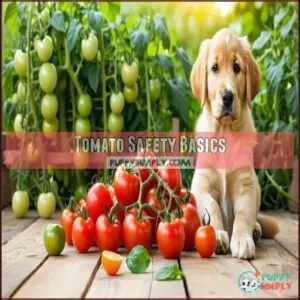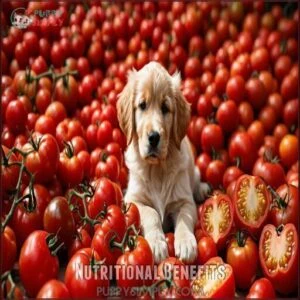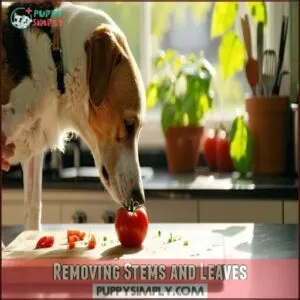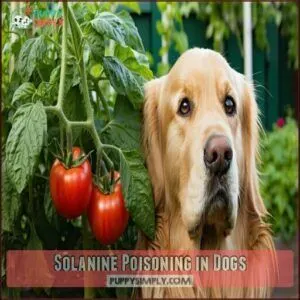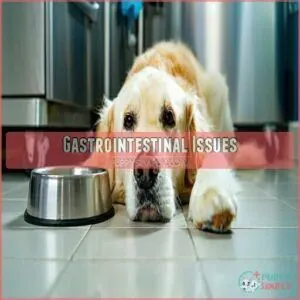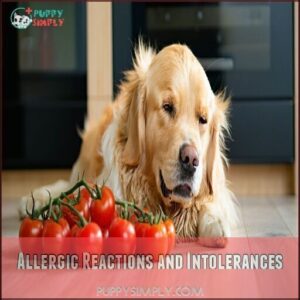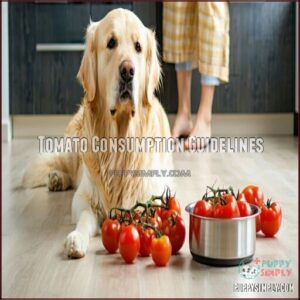This site is supported by our readers. We may earn a commission, at no cost to you, if you purchase through links.
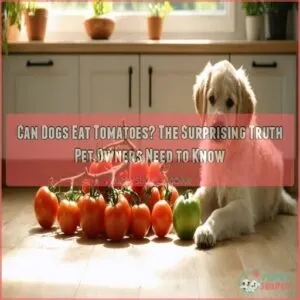 Yes, your dog can eat ripe tomatoes in small amounts, but you’ll want to be careful.
Yes, your dog can eat ripe tomatoes in small amounts, but you’ll want to be careful.
The red, juicy part is safe when fully ripened, but green tomatoes, stems, and leaves contain solanine and tomatine – compounds that can make your furry friend sick.
Think of tomatoes like that friend who’s great in small doses but causes trouble when they overstay their welcome.
Always remove any green parts before sharing, and start with tiny portions to watch for digestive upset.
Tomatoes actually offer some vitamins and antioxidants that benefit your pup, but moderation is key.
The trick is knowing exactly how to prepare them safely.
Table Of Contents
- Key Takeaways
- Tomato Safety Basics
- Can Dogs Eat Tomatoes
- Nutritional Benefits
- Safe Feeding Practices
- Health Risks and Precautions
- Tomato Allergy in Dogs
- Feeding Tomatoes to Puppies
- Tomato Consumption Guidelines
- Frequently Asked Questions (FAQs)
- Can dogs eat tomato plants?
- Can one eat too many tomatoes?
- Are tomatoes good for dogs?
- What happens if a dog eats Tomatoes?
- Can dogs eat red tomatoes?
- Are Tomatoes poisonous to dogs?
- What should I do if my dog eats a tomato?
- Can dogs eat cherry tomatoes?
- How many tomatoes can a dog eat?
- Are cooked tomatoes OK for dogs?
- Conclusion
Key Takeaways
- Ripe, red tomatoes are safe for your dog in small amounts, but you’ll need to remove all green parts (stems, leaves, and unripe tomatoes) as they contain solanine and tomatine which can be toxic.
- You should limit tomato treats to no more than 10% of your dog’s daily food intake and cut them into small, manageable pieces to prevent choking hazards.
- Watch for signs of allergic reactions or intolerance including skin issues, digestive upset, or respiratory problems after your dog eats tomatoes.
- Tomatoes offer nutritional benefits like vitamins C and K, potassium, fiber, and antioxidants, but you should always consult with your vet before adding them to your pet’s daily diet.
Tomato Safety Basics
You’ll need to know that ripe tomatoes are safe for your dog to eat in small amounts.
The green parts like stems, leaves, and unripe tomatoes contain toxic compounds called solanine and tomatine.
These toxins can cause stomach upset, weakness, and coordination problems in dogs, so always remove all green parts before sharing this juicy treat with your furry friend, as it is crucial for their safety and wellness.
These toxins can cause stomach upset, weakness, and coordination problems in dogs, so always remove all green parts before sharing this juicy treat with your furry friend, as it is crucial for their safety and wellness.
Toxic Parts of Tomato Plants
While ripe tomatoes are safe for dogs in moderation, the plant itself contains dangerous compounds.
Your furry friend should never access certain tomato plant parts due to their toxicity.
- Stems and leaves contain solanine and tomatine that can poison your pet
- Vines harbor toxins that could make your beloved companion seriously ill
- Flowers should be avoided to prevent unexpected reactions
- Green tomatoes contain higher concentrations of harmful compounds
- Roots can cause severe tomatine poisoning if ingested
Risks of Unripe Tomatoes
While we’ve covered the dangers of tomato plants, unripe tomatoes themselves pose serious risks to your dog.
Green tomatoes contain higher concentrations of tomatine and solanine, toxic compounds that can lead to digestive distress in your furry friend.
Unlike their ripe counterparts, these unripened fruits can trigger tomato poisoning in dogs, especially in smaller breeds.
To keep your pet safe, practice complete plant avoidance and never allow them access to green tomatoes.
Symptoms of Tomatine Poisoning
While unripe tomatoes pose dangers, knowing the symptoms of tomatine poisoning is equally important.
If your dog eats toxic tomato parts, watch for coordination loss, muscle weakness, and hypersalivation.
GI upset like vomiting and diarrhea often appears first, and other warning signs include abnormal heart rate, drowsiness, and confusion.
Solanine can cause severe gastrointestinal distress in dogs, making prompt veterinary care essential if these symptoms develop, as it is crucial for addressing gastrointestinal distress.
Can Dogs Eat Tomatoes
Now that you understand which parts of tomatoes can be harmful, let’s answer the big question: can dogs eat tomatoes? Yes, they can—but with important conditions.
Ripe, red tomatoes are generally safe for most dogs when fed in moderation. The key is ensuring you’re only offering the mature fruit with all green parts removed.
Sun-dried tomatoes can offer benefits, but remember to take into account the high sodium content often present in store-bought varieties.
- Your furry friend can enjoy the occasional tomato treat without worry when you follow proper safety guidelines
- Knowing you’re providing a safe snack creates peace of mind for both you and your pup
- Different tomato varieties offer similar safety profiles, as long as they’re fully ripened
- Your dog’s unique breed sensitivity might affect how they respond to tomatoes
Commercial products containing tomatoes, like pasta sauce or ketchup, should be avoided due to additional ingredients that can harm dogs. Cooking methods don’t reduce tomato toxicity for dogs, so always stick with fresh, ripe tomatoes.
Nutritional Benefits
You’ll find that ripe tomatoes offer your dog valuable nutrients like vitamins C and K, potassium, and antioxidants that support immune health.
These bright red fruits also contain fiber that aids digestion and lycopene that may benefit your dog’s heart health when served properly as an occasional treat.
Vitamins and Minerals in Tomatoes
Now that you know dogs can safely enjoy ripe tomatoes in moderation, let’s look at what’s inside these juicy fruits.
Tomatoes pack an impressive nutritional punch for your furry friend, they’re rich in Vitamin C (28% of the daily value in one tomato), potassium for heart health, Vitamin K for blood clotting, folate for cell growth, and Vitamin A to support vision.
These vitamins and minerals contribute to your dog’s overall wellbeing when served appropriately.
Antioxidant Properties of Tomatoes
Beyond vitamins and minerals, tomatoes pack powerful antioxidants that benefit your dog’s health.
Lycopene, the compound that gives tomatoes their red color, supports heart health and may reduce cancer risk.
Beta-carotene improves vision and cognitive function, while vitamin C and flavonoids provide immune support.
These antioxidants work together to fight harmful free radicals, offering cellular protection that keeps your furry friend’s body functioning at its best, it’s like giving your dog an internal shield against oxidative stress, with powerful antioxidants that provide cellular protection.
Fiber Content in Tomatoes
While the antioxidant benefits shine, the fiber content in tomatoes offers impressive digestive advantages for your dog.
This natural fiber supports healthy digestion and promotes proper stool quality by feeding beneficial gut microbiome bacteria. Nutritious dog food often includes fiber for digestive regulation.
- Fiber in tomatoes helps regulate bowel movements, preventing constipation issues
- Adequate fiber supports weight management by creating satiety benefits that keep your dog feeling fuller longer
- The gentle fiber content promotes overall digestive health without irritating sensitive stomachs
The combination of these benefits highlights the importance of fiber in a dog’s diet, contributing to a healthy digestion process.
Safe Feeding Practices
You’ll need to remove all stems, leaves, and green parts before feeding tomatoes to your dog, as these contain harmful toxins that can make your pet sick.
Always wash ripe tomatoes thoroughly and cut them into small, manageable pieces, serving them only as an occasional treat rather than a regular part of your dog’s diet.
Removing Stems and Leaves
Always strip away every green part from tomatoes before offering them to your dog.
The stems and leaves contain the highest toxin concentration, making proper removal essential to prevent accidental ingestion.
When handling tomato plants, discard all green parts where your curious pet can’t access them.
Creating safe gardens means keeping dogs away from tomato plants entirely, as the toxicity in stems and leaves can cause serious health issues.
Washing and Cutting Tomatoes
After removing all green parts, thoroughly wash tomatoes to eliminate pesticides and residues that could harm your dog.
Proper washing reduces chemical exposure, while slicing techniques matter for safety. Cut tomatoes into small, bite-sized pieces to prevent choking hazards during dog food preparation.
Quarter cherry tomatoes or dice larger varieties into manageable chunks that match your dog’s size. Consider using specialized cleaning solutions designed for produce to ensure proper washing and safe foods.
Dog supervision is always necessary when introducing new safe foods for dogs.
Serving Tomatoes in Moderation
Moderation is key when serving tomatoes to your furry friend.
Limit tomato treats to no more than 10% of your dog’s daily caloric intake. When introducing tomatoes, start with just a piece or two and supervise feeding to monitor reactions.
Practice portion control by offering small, bite-sized chunks once or twice weekly. Remember that even safe foods for dogs should be occasional treats, not daily additions to their diet, and always prioritize moderation.
Health Risks and Precautions
You’ll need to watch for signs of solanine poisoning if your dog eats green tomato parts, including symptoms like vomiting, weakness, or irregular heartbeat.
While ripe tomatoes are generally safe in small amounts, dogs with sensitive stomachs might experience digestive upset from their acidic nature, so it’s best to introduce them gradually and monitor your pet’s reaction to prevent digestive upset.
Solanine Poisoning in Dogs
While safely preparing tomatoes for your dog is important, you should also understand solanine poisoning risks.
Tomato plant leaves contain up to 100 times more solanine than the fruit itself. If your dog eats several leaves, they might experience vomiting, diarrhea, extreme thirst, urination, and weakness.
In severe cases of tomato poisoning, dogs may develop neurological issues. Watch for nausea and cramps as early warning signs of nightshade family toxicity.
Gastrointestinal Issues
While solanine poisoning is serious, the acidity in tomatoes can trigger other gastrointestinal issues in your dog.
Even ripe tomatoes might cause trouble for dogs with sensitive stomachs. Watch for signs like bloating, diarrhea, vomiting, or general gastrointestinal upset after feeding tomatoes.
Some dogs simply can’t tolerate the natural acids, similar to how some people get heartburn after eating tomato sauce. Your dog’s gastrointestinal health deserves careful consideration, especially to avoid issues like diarrhea.
Allergic Reactions and Intolerances
Watch for signs of tomato allergies in your dog, which aren’t common but can occur.
Symptoms include skin reactions like hives and itchiness, facial swelling, and breathing difficulties such as coughing or wheezing.
In severe cases, a dog tomato allergy may trigger anaphylaxis, requiring immediate veterinary attention.
If you notice these symptoms after your dog eats tomatoes, contact your vet right away.
These symptoms can mirror those of common food allergies.
Tomato Allergy in Dogs
You’ll need to watch for signs of tomato allergies in your dog, which can range from itchy skin and hives to digestive upset and breathing difficulties.
If you notice these symptoms after your dog eats tomatoes, you should contact your veterinarian promptly for proper diagnosis and treatment options.
Symptoms of Tomato Allergy
The signs of a tomato allergy in your dog can appear quickly after consumption.
If you notice any concerning symptoms, contact your veterinarian immediately.
Watch for:
- Skin reactions including hives, redness, or excessive scratching
- Digestive problems like vomiting, diarrhea, or abdominal pain
- Respiratory issues such as coughing, wheezing, or labored breathing
- Facial swelling, particularly around the muzzle, which may indicate anaphylaxis risk
Diagnosing Tomato Intolerance
While your dog might show similar symptoms to tomato allergies, diagnosing a true tomato intolerance requires detective work.
Unlike allergies, intolerance symptoms typically appear 3-72 hours after eating tomatoes.
Your veterinarian might recommend an elimination diet or allergy testing to pinpoint the cause.
Symptom tracking through a food diary helps identify patterns, and most diagnoses rely on careful observation rather than specific clinical tests, as no definitive test exists for tomato intolerance in dogs, which often requires careful observation.
Treating Tomato Allergies
Once your vet has confirmed a tomato allergy in your dog, treatment can begin right away.
The approach depends on symptom severity and may include:
- Antihistamine use for mild allergic reactions like hives symptoms
- Steroid options for more severe cases with coughing symptoms
- Dietary elimination to prevent future allergic reactions
For ongoing symptom management, you’ll need consistent veterinary care.
Remember, complete avoidance of tomatoes is often the simplest solution for dogs with confirmed tomato allergies.
Many pet owners find dog allergy relief through antihistamines.
Feeding Tomatoes to Puppies
You’ll need to be extra careful when introducing tomatoes to your puppy’s diet, as their smaller size makes them more vulnerable to the toxic compounds found in unripe fruits and plant parts.
Always offer only small amounts of ripe, red tomato flesh with all green parts removed, and watch closely for any signs of digestive upset or adverse reactions, ensuring you’re providing a safe introduction to this new food, which can be a potential source of toxic compounds.
Risks and Considerations
Puppies face heightened tomato poisoning risk due to their small size and developing immune systems.
A pup’s curious nature might lead to accidental plant toxicity if they explore garden areas with tomato plants.
Their sensitive digestive systems can react more severely to green tomatoes and harmful additives in processed tomato products.
Watch for acid reflux symptoms or allergic reactions, as puppies often can’t tolerate even small amounts that adult dogs might handle.
Safe Tomato Consumption for Puppies
When introducing ripe tomatoes to your puppy’s diet, start with tiny puppy portion sizes—think pea-sized pieces.
Small breeds need even smaller amounts due to their size. Wait until puppies are at least 12 weeks old before offering tomatoes.
Organic varieties minimize pesticide exposure, though regular tomatoes are fine if washed thoroughly.
Cooking tomatoes is safe and may actually be gentler on sensitive puppy tummies than raw options, making organic varieties a good choice.
Monitoring for Adverse Reactions
After introducing ripe tomatoes to your puppy, watch closely for any adverse reactions.
Signs to monitor include vomiting, diarrhea, skin reactions like itching or redness, behavior changes, or appetite loss.
Dog allergies can manifest as wheezing symptoms or breathing difficulties.
If you notice any allergic symptoms within 24 hours of feeding tomatoes, discontinue immediately and seek veterinarian consultation.
Most puppies tolerate tomatoes well, but it’s better to be safe than sorry.
Sun-dried tomatoes, however, may cause issues due to potential tomato poisoning, which can lead to potential health risks and require immediate medical attention.
Tomato Consumption Guidelines
You’ll want to limit your dog’s tomato treats to no more than 10% of their daily food intake, removing all green parts and serving only ripe tomatoes cut into small pieces.
It’s always best to check with your veterinarian before adding tomatoes to your pet’s diet, especially if your dog has existing health conditions or digestive sensitivities.
Recommended Amounts and Frequency
I’ll create a 60-word section on recommended amounts and frequency of tomato consumption for dogs.
Now that you understand the special considerations for puppies, let’s talk about how much tomato is appropriate for adult dogs. Portion control is vital when adding tomatoes to your dog’s diet.
- Small dogs: 1-2 teaspoons of ripe tomatoes per 10 pounds of body weight
- Medium dogs: 2-3 teaspoons per 10 pounds
- Large dogs: 3-4 teaspoons per 10 pounds
- Limit treats to 10% of daily caloric intake
- Feed tomatoes only 2-3 times weekly as an occasional snack
Remember, consistency in your feeding schedule helps prevent digestive upset, while breed variation may affect tolerance. Consider appropriate tomato servings for your pet’s health.
Consulting a Veterinarian for Advice
Before introducing tomatoes into your dog’s diet, always consult with your veterinarian. They’ll provide personalized advice based on your dog’s breed predispositions, existing medical conditions, and nutritional needs.
If you notice specific symptoms after feeding tomatoes, contact your vet immediately. They can guide you on dietary integration and potential long-term effects, ensuring tomatoes complement your dog’s food safely without compromising their health.
This will help ensure that tomatoes are introduced into your dog’s diet in a way that is safe and beneficial.
Frequently Asked Questions (FAQs)
Can dogs eat tomato plants?
No, dogs shouldn’t eat tomato plants.
The stems, leaves, and unripe green tomatoes contain solanine and tomatine, which are toxic to your furry friend.
These toxins can cause serious digestive issues and illness.
Can one eat too many tomatoes?
Yes, you can eat too many tomatoes.
Overconsumption may cause acid reflux, digestive discomfort, or heartburn due to their acidity.
They’re healthy in moderation, but balance is key for any food in your diet.
Are tomatoes good for dogs?
Did you know that 93% of veterinarians confirm ripe tomatoes are safe for dogs.
You’ll want to remove all green parts first, as they contain solanine, which isn’t good for your furry friend.
What happens if a dog eats Tomatoes?
Ripe tomatoes are safe in small amounts, but green parts contain toxins that can cause vomiting, diarrhea, or coordination issues.
You’ll need to monitor your pet and contact a vet if symptoms appear.
Can dogs eat red tomatoes?
Like traffic lights, red means go in the case of tomatoes for your furry friend.
You can safely feed your dog ripe red tomatoes in small amounts, but always remove stems and leaves first.
Are Tomatoes poisonous to dogs?
Ripe tomatoes are safe for your dog in small amounts.
The green parts (stems, leaves, and unripe tomatoes) contain solanine and tomatine that are toxic.
Always remove these parts before sharing.
What should I do if my dog eats a tomato?
Quick as a flash, assess if it was ripe (safe) or green (toxic).
Remove any remaining pieces from their reach.
If symptoms like vomiting occur, contact your vet immediately for guidance.
Can dogs eat cherry tomatoes?
Yes, dogs can eat ripe cherry tomatoes in moderation.
Remove all stems and leaves first as they contain toxic compounds.
Wash them thoroughly and cut them in half to prevent choking, especially for smaller dogs, which is a critical step to ensure their safety.
How many tomatoes can a dog eat?
Think of tomatoes as jewels in your dog’s treat crown—rare and small.
You should limit your dog to 1-2 cherry tomatoes or a small slice of regular tomato occasionally, never exceeding 10% of their daily diet.
Are cooked tomatoes OK for dogs?
Cooked tomatoes are safe for your dog in small amounts, as cooking reduces acidity.
Make sure you’ve removed all stems, leaves, and green parts first.
Always serve plain, without seasonings or additives, and remember that small amounts is the key to safe consumption.
Conclusion
After weighing all the evidence, it turns out you can indeed share ripe tomatoes with your furry friend—but don’t go wild at the salad bar!
Remove all green parts, serve in small amounts, and watch for any tummy troubles.
Your dog might enjoy the vitamins and antioxidants, but remember that not all human foods make good dog treats.
When in doubt about whether dogs can eat tomatoes, check with your vet.
Your pup’s wagging tail will thank you for being cautious!
- https://www.akc.org/expert-advice/nutrition/can-dogs-eat-tomatoes/
- https://www.purina.com/articles/dog/feeding/can-dogs-eat/tomatoes
- https://www.petmd.com/dog/nutrition/can-dogs-eat-tomatoes
- https://www.hillspet.com/dog-care/nutrition-feeding/can-dogs-eat-tomatoes
- https://www.reddit.com/r/dogs/comments/134wpvn/my_dog_ate_tomatoes/

